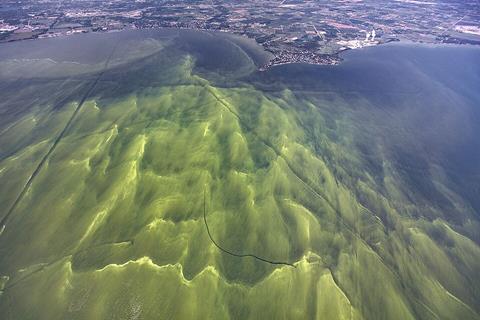Living close to cyanobacterial harmful algal blooms — which are present nationwide across the US but are more common in coastal and Great Lake states — heightens the rate of dying from amyotrophic lateral sclerosis, or ALS, a study suggests.

These blooms occur when cyanobacteria, also called blue-green algae, grows dense and out of control, producing toxic agents that can poison people and the environment.
READ MORE: Researchers to study links between Great Lakes algal blooms and human health
READ MORE: Bacterial villain behind Lake Erie’s ‘potent toxin’ unveiled by study
Researchers at Michigan Medicine surveyed participants with ALS who were seen at the University of Michigan Pranger ALS Clinic.
Investigators measured the duration and extent of each participant’s exposure to cyanobacterial harmful algal blooms by compiling their residential and health histories, as well as satellite data from the Cyanobacteria Assessment Network.
Life near blooms
Many participants lived within three miles of a harmful algal bloom. Living near blooms, especially if swimming, boating or using a local and possibly contaminated water source, was associated with dying of ALS nearly one year sooner.
The results are published in the International Journal of Environmental Research and Public Health.
“Harmful algal blooms are a growing problem across the country, and it is not uncommon for people to live near them,” said senior author Stephen Goutman, M.D., Harriet Hiller Research Professor, director of the Pranger ALS Clinic and associate director of the ALS Center of Excellence at University of Michigan.
“Our study shows a clear link between living in close proximity to cyanobacteria blooms over the course of one’s life and adverse outcomes of ALS.”
Exposure to cyanobacteria
People may be exposed to cyanobacteria toxins through ingestion, inhalation and contact with the skin from several activities, such as swimming and fishing.
In the study, people with the most significant exposures both lived near harmful blooms and used a private well as their water source.
Cyanobacteria produce several toxic agents that are linked neurodegenerative diseases, including ALS, Alzheimer’s and Parkinson’s.
Toxic agents
One such toxin, called ß-methylamino-L-alanine, has been detected in brain and cerebral spinal fluid samples of participants with ALS.
“While there is still limited research into the mechanism by which cyanobacteria toxins affect neurodegenerative diseases, our findings suggest that living near or participating in activities in these water bodies may influence the progression of ALS,” Goutman said.
ALS is in part influenced by genetics, but the disease is also largely driven by environmental factors.
ALS exposome
The accumulation of exposures to toxins and pollutants, such as pesticides and volatile organic compounds, is known as the ALS exposome.
In the United States, cases of ALS are highest in the Midwest.
Researchers believe that is in part due to pervasive industrial and agricultural productions in the region.
Inland lakes
“If exposure to cyanobacteria toxins is a meaningful risk factor for ALS, the large number of inland lakes from to such bacteria in the Midwest may partly explain why the disease incidence is much higher than other parts of the country,” said Stuart Batterman, Ph.D., first author and professor of environmental health sciences at the U-M School of Public Health.
“Given the complexity of ALS, we must maintain an epidemiological approach that encompasses environmental exposures over the life course. These studies provide will continue to provide insight into risk facts associated with disease onset and the effects on survival.”
Additional authors: Md Kamrul Islam, M.S., Dae Gyu Jang, Ph.D., and Eva L. Feldman, M.D., Ph.D., all of University of Michigan.







No comments yet